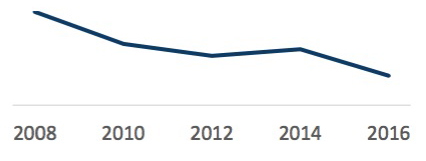Progress
Where We Were
Homeless counts, conducted biennially since 1999, showed the number of people experiencing homelessness was steadily rising, with the highest count occurring in 2008.
Edmonton’s mayor at that time Stephen Mandel understood that something had to be done. He struck Edmonton’s Committee to End Homelessness and appointed a wide spectrum of community leaders to the Committee: business people, labour leaders, managers of philanthropic organizations, social agency directors, politicians and faith leaders.
In January 2009, Edmonton’s Plan to End Homelessness was adopted. It was based on the Housing First principle with 5 tangible, measurable goals. Each goal has its own targets and strategies.
Where We Are
Edmonton’s social and economic context has changed significantly since the launch of the Plan in 2009. Two significant economic downturns (2009 and 2016) and several extreme weather events (the 2013 Calgary floods and 2016 Fort McMurray wildfires) have placed additional pressure on social service agencies to support Edmontonians in need.
In October 2016, 1,752 people were counted who identified as experiencing homelessness, a 24% decrease from the previous Homeless Count in 2014 and a 43% decrease since 2008.
Although progress is being made, there is still much work to do. We need to refocus our efforts until every Edmontonian has a place to call home.
43% Decreasein the number of people counted experiencing homelessness from 2008-2016

Vacancy Rate and Rent
Edmonton’s market vacancy rate fell from 4.4% in 2009 to 1.4% in 2013 and then jumped to 7.1% by October 2016. Average rent for a 1-bedroom climbed from $842 to $999.
4.4%
2009
1.4%
2013
7.1%
October 2016
Unemployment Rate
Edmonton’s seasonally adjusted unemployment rate was 7.4% in December 2009 and December 2016. In between, it reached a low of 4.0%.
In the past, homelessness was viewed as a problem to be managed – with shelters, drop-in centres and other emergency supports. People had to be prepared for, or transitioned into, housing. They needed to deal with mental health problems, tackle addiction issues or find a job first.
The Housing First philosophy turns that approach upside down. The first step is to find a homeless person their own permanent home. The next step is to ensure he has the supports he needs to be successful in that home. Because the best place to tackle the underlying issues that lead to homelessness is in safe, secure housing – not on the streets.
Housing First
5,917 people (clients and dependents) were housed in Housing First programs from 2009-2016.
Where We Need to Go
We believe that ending homelessness in Edmonton is an achievable goal. As we reflect on how far we have come, we know more now than when the Plan was first launched. We know what works and we have been able to identify gaps.
Permanent Supportive Housing
We need to focus on solutions: permanent, appropriate, safe and affordable housing with necessary supports to sustain it must be invested in and must be available throughout our city. Permanent supportive housing combines affordable housing with wrap-around supportive services. It is a proven, cost effective solution for those experiencing chronic homelessness.
It Takes a Community
Ending homelessness takes all of us working together. By supporting and investing in solutions, our community becomes stronger and more diverse. Research has shown us that the benefits of housing someone not only increase housing stability, but also improve overall well being, including health, economic status, and relationships.